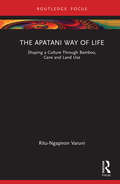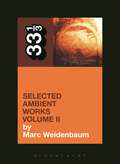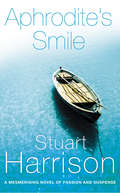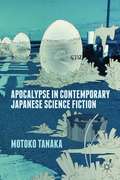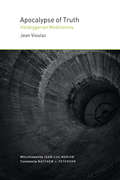- Table View
- List View
Apartheid: A Documentary Study of Modern South Africa (Routledge Library Editions: South Africa #2)
by Edgar H. BrookesOriginally published in 1968, this volume traces the history and growth of Apartheid in South Africa. The acts which enforced Apartheid – the Group Areas Act, Population and Registration Act are given in full. The book also includes documents which reflected reaction to these measures: Parliamentary debates, newspaper reports and policy statements by the leading political parties and religious denominations. The documents are headed by a full historical and analytical introduction.
Apartheid, 1948-1994 (Oxford Histories)
by Saul DubowThis new study offers a fresh interpretation of apartheid South Africa. Emerging out of the author's long-standing interests in the history of racial segregation, and drawing on a great deal of new scholarship, archival collections, and personal memoirs, he situates apartheid in global as well as local contexts. The overall conception of Apartheid, 1948-1994 is to integrate studies of resistance with the analysis of power, paying attention to the importance of ideas, institutions, and culture. Saul Dubow refamiliarises and defamiliarise apartheid so as to approach South Africa's white supremacist past from unlikely perspectives. He asks not only why apartheid was defeated, but how it survived so long. He neither presumes the rise of apartheid nor its demise. This synoptic reinterpretation is designed to introduce students to apartheid and to generate new questions for experts in the field.
Apartheid and Anti-Apartheid in Western Europe (Cambridge Imperial and Post-Colonial Studies)
by Knud Andresen Sebastian Justke Detlef SiegfriedThis edited collection examines how Western European countries have responded and been influenced by the apartheid system in South Africa. The debate surrounding apartheid in South Africa underwent a shift in the second half of the 20th century, with long held positive, racist European opinions of white South Africans slowly declining since decolonisation in the 1960s, and the increase in the importance of human rights in international politics. While previous studies have approached this question in the context of national histories, more or less detached from each other, this edited collection offers a broader insight into the transnational and entangled histories of Western European and South African societies. The contributors use exemplary case studies to trace the change of perception, covering a plurality of reactions in different societies and spheres: from the political and social, to the economic and cultural. At the same time, the collection emphasizes the interconnections of those reactions to what has been called the last ‘overtly racist regime’ (George Frederickson) of the twentieth century.
Apartheid Guns and Money: A Tale of Profit
by Hennie van VuurenIn its last decades, the apartheid regime was confronted with an existential threat. While internal resistance to the last whites-only government grew, mandatory international sanctions prohibited sales of strategic goods and arms to South Africa. To counter this, a global covert network of nearly fifty countries was built. In complete secrecy, allies in corporations, banks, governments and intelligence agencies across the world helped illegally supply guns and move cash in one of history's biggest money laundering schemes. Whistleblowers were assassinated and ordinary people suffered. Weaving together archival material, interviews and newly declassified documents, Apartheid Guns and Money exposes some of the darkest secrets of apartheid's economic crimes, their murderous consequences, and those who profited: heads of state, arms dealers, aristocrats, bankers, spies, journalists and secret lobbyists. These revelations, and the difficult questions they pose, will both allow and force the new South Africa to confront its past.
Apartheid on a Black Isle: Removal and Resistance in Alexandra, South Africa
by D. CurryIn this single square mile hemmed in by White areas, residents engaged in what is arguably the most multi-faceted, inventive, and versatile strategy of resistance during the 1970s. Apartheid on a Black Isle brings to the fore the definitive but underappreciated role that Alexandra played in advancing human rights. Using their manufactured space, Alexandrans revolutionized the South African freedom struggle by fertilizing the underground movement, by joining in solidarity with Soweto during the student uprising and by finding unique ways to grieve. This book explores and introduces ordinary Alexandrans whose narratives challenged preconceived notions of resistance, identity, gender and space.
The Apatani Way of Life: Shaping a Culture Through Bamboo, Cane and Land Use
by Ritu VaruniThis book celebrates the heritage of the distinctive Apatani community of the north-eastern Himalayan state of Arunachal Pradesh in India. It explores the fascinating indigenous knowledge of field and forest and a uniquely sustainable and enduring way of life that continues to evolve in the modern context. The book tells the story of how a material culture was shaped around bamboo and cane resources and nurtured by a strong community spirit and spirituality that transcended the human world and maintained an unbroken ethos of conservation through time. It highlights the eco-sensitive lifestyle of this unique community and presents an in-depth analysis of the Apatani tradition of the exemplary use of natural resources. Through this engrossing detailed study, the author observes how bamboo houses are built in three days, fish cultivated in a rice field and a single river used for millennia to feed an entire community. She highlights the triumph of the human spirit in engineering a cultural landscape out of a swamp, and how peaceful co-existence with nature can withstand the trials of time. Part autobiographical and powerfully personal, this book is a primer on sustainable living as practice. It will be of interest to researchers and students of tribal and Himalayan vernacular architecture, traditional bamboo-cane craft, urban ecology and geography, cultural studies, and sustainability. It will also attract general readership while being academically useful for anthropologists, sociologists, botanists, ecologists and environmentalists.
The Apatani Way of Life: Shaping a Culture Through Bamboo, Cane and Land Use
by Ritu VaruniThis book celebrates the heritage of the distinctive Apatani community of the north-eastern Himalayan state of Arunachal Pradesh in India. It explores the fascinating indigenous knowledge of field and forest and a uniquely sustainable and enduring way of life that continues to evolve in the modern context. The book tells the story of how a material culture was shaped around bamboo and cane resources and nurtured by a strong community spirit and spirituality that transcended the human world and maintained an unbroken ethos of conservation through time. It highlights the eco-sensitive lifestyle of this unique community and presents an in-depth analysis of the Apatani tradition of the exemplary use of natural resources. Through this engrossing detailed study, the author observes how bamboo houses are built in three days, fish cultivated in a rice field and a single river used for millennia to feed an entire community. She highlights the triumph of the human spirit in engineering a cultural landscape out of a swamp, and how peaceful co-existence with nature can withstand the trials of time. Part autobiographical and powerfully personal, this book is a primer on sustainable living as practice. It will be of interest to researchers and students of tribal and Himalayan vernacular architecture, traditional bamboo-cane craft, urban ecology and geography, cultural studies, and sustainability. It will also attract general readership while being academically useful for anthropologists, sociologists, botanists, ecologists and environmentalists.
Apeiron: Anaximander on Generation and Destruction (SpringerBriefs in Philosophy)
by Radim Kočandrle Dirk L. CouprieThis book offers an innovative analysis of the Greek philosopher Anaximander’s work. In particular, it presents a completely new interpretation of the key word Apeiron, or boundless, offering readers a deeper understanding of his seminal cosmology and, with it, his unique conception of the origin of the universe. Anaximander traditionally applied Apeiron to designate the origin of everything. The authors’ investigation of the extant sources shows, however, that this common view misses the mark. They argue that instead of reading Apeiron as a noun, it should be considered an adjective, with reference to the term phusis (nature), and that the phrase phusis apeiros may express the boundless power of nature, responsible for all creation and growth. The authors also offer an interpretation of Anaximander's cosmogony from a biological perspective: each further step in the differentiation of the phenomenal world is a continuation of the original separation of a fertile seed. This new reading of the first written account of cosmology stresses the central role of the boundless power of nature. It provides philosophers, researchers, and students with a thought-provoking explanation of this early thinker's conception of generation and destruction in the universe.
Apes and Monkeys on the Early Modern Stage, 1603–1659 (Early Modern Literature in History)
by Teresa GrantThis book is the first full-length study of apes and monkeys on the early modern stage. It broadens the scope of existing scholarship by situating the apes glimpsed in Shakespeare’s plays in the wider context of the many uncelebrated uses by other playwrights, c. 1603-1659. The book investigates the theatrical appearances of real monkeys, actors dressed up as apes, and characters mistaken for them, arguing that the ape trope is so insistent in early modern drama that it becomes a structural metaphor. It addresses both plays and masques across the period, arguing that the ways of seeing in these different kinds of theatre make apes mean differently in their generic contexts. Grounded in historicist readings, this book also draws significantly on the field of ritual studies and the new intersectional discipline of animal performance studies.
Aphex Twin's Selected Ambient Works Volume II (33 1/3)
by Marc WeidenbaumExtravagantly opaque, willfully vaporous - Aphex Twin's Selected Ambient Works Volume II, released by the estimable British label Warp Records in 1994, rejuvenated ambient music for the Internet Age that was just dawning. In the United States, it was Richard D. James's first full length on Sire Records (home to Madonna and Depeche Mode) under the moniker Aphex Twin; Sire helped usher him in as a major force in music, electronic or otherwise.Faithful to Brian Eno's definition of ambient music, Selected Ambient Works Volume II was intentionally functional: it furnished chill out rooms, the sanctuaries amid intense raves. Choreographers and film directors began to employ it to their own ends, and in the intervening decades this background music came to the fore, adapted by classical composers who reverse-engineered its fragile textures for performance on acoustic instruments. Simultaneously, "ambient†? has moved from esoteric sound art to central tenet of online culture. This book contends that despite a reputation for being beatless, the album exudes percussive curiosity, providing a sonic metaphor for our technologically mediated era of countless synchronized nanosecond metronomes.
Aphex Twin's Selected Ambient Works Volume II (33 1/3)
by Marc WeidenbaumExtravagantly opaque, willfully vaporous - Aphex Twin's Selected Ambient Works Volume II, released by the estimable British label Warp Records in 1994, rejuvenated ambient music for the Internet Age that was just dawning. In the United States, it was Richard D. James's first full length on Sire Records (home to Madonna and Depeche Mode) under the moniker Aphex Twin; Sire helped usher him in as a major force in music, electronic or otherwise.Faithful to Brian Eno's definition of ambient music, Selected Ambient Works Volume II was intentionally functional: it furnished chill out rooms, the sanctuaries amid intense raves. Choreographers and film directors began to employ it to their own ends, and in the intervening decades this background music came to the fore, adapted by classical composers who reverse-engineered its fragile textures for performance on acoustic instruments. Simultaneously, “ambient” has moved from esoteric sound art to central tenet of online culture. This book contends that despite a reputation for being beatless, the album exudes percussive curiosity, providing a sonic metaphor for our technologically mediated era of countless synchronized nanosecond metronomes.
Aphrodite and the Duke: The perfect Regency romance that will steal your heart (Aphrodite and the Duke)
by J.J. McAvoy'Full of lush gowns, longing looks and lingering secrets, Bridgerton lovers have found their next read in Aphrodite and the Duke. JJ McAvoy is a welcome new voice in historical romance' SARAH MACLEAN, NEW YORK TIMES bestselling author of A DUKE WORTH FALLING FORAphrodite wishes to escape the marriage mart but will a second chance with the elusive Duke of Everely change her mind?Aphrodite Du Bell is a diamond of the first water and a favourite of the queen. Famed for her beauty, the members of the ton praise her warm brown skin, perfect curls and exquisite features. But her renowned loveliness didn't stop the love of her life, Evander Eagleman, from jilting her and marrying another woman four years ago.Heartbroken and still not knowing why the Duke threw her over, Aphrodite has been in self-imposed exile ever since. However, when her formidable mother summons her back to London to aid in her sister Hathor's debut into society, Aphrodite has no choice but to acquiesce.Upon her return, Aphrodite learns that the newly widowed Evander is in town for his sister Verity's debut. Naturally, Aphrodite resolves not to be in his presence, but despite her best efforts, the grand societal events of the season repeatedly push them together. With each encounter, buried passions reignite and Aphrodite's traitorous feelings make it perfectly clear that the Duke still holds court over her heart.Can the couple make strides to mend past hurts, or will the true reason Evander pushed Aphrodite aside threaten their coveted future and even their lives . . . ?
Aphrodite’s Smile (Charnwood Large Print Ser.)
by Stuart HarrisonA novel of romantic suspense, set on the beautiful Greek island of Ithaca, from the author of STILL WATER and THE SNOW FALCON.
The Apocalypse: A Brief History (Wiley Blackwell Brief Histories of Religion)
by Martha HimmelfarbThis accessible and enlightening history provides insights into the fascinating genre of apocalyptic literature, showing how the apocalypse encompasses far more than popular views of the last judgment and violent end of the world might suggest. An accessible and enlightening history of the "apocalypses"--ancient Jewish and Christian works -- providing fresh insights into the fascinating genre of literature Shows how the apocalypses were concerned not only with popular views of the last judgment and violent end of the world, but with reward and punishment after death, the heavenly temple, and the revelation of astronomical phenomena and other secrets of nature Traces the tradition of apocalyptic writing through the Middle Ages, through to the modern era, when social movements still prophesise the world’s imminent demise
Apocalypse and Golden Age: The End of the World in Greek and Roman Thought
by Christopher StarHow did the ancient Greeks and Romans envision the end of the world?What is the long-term future of the human race? Will the world always remain as it is or will it undergo a catastrophic change? What role do the gods, human morality, and the forces of nature play in bringing about the end of the world? In Apocalypse and Golden Age, Christopher Star reveals the answers that Greek and Roman authors gave to these questions. The first large-scale investigation of the various scenarios for the end of the world in classical texts, this book demonstrates that key thinkers often viewed their world as shaped by catastrophe. Star focuses on how this theme was explored over the centuries in the works of poets, such as Hesiod, Vergil, Ovid, and Lucan, and by philosophers, including the Presocratics, Plato, Epicurus, Lucretius, Cicero, and Seneca. With possibilities ranging from periodic terrestrial catastrophes to the total dissolution of the world, these scenarios address the ultimate limits that define human life and institutions, and place humanity in the long perspective of cosmic and natural history. These texts also explore various options for the rebirth of society after world catastrophe, such as a return of the Golden Age or the redevelopment of culture and political institutions. Greek and Roman visions of the end, Star argues, are not calls to renounce this world and prepare for a future kingdom. Rather, they are set within larger investigations that examine and seek to improve personal and political life in the present. Contextualizing classical thought about the apocalypse with biblical studies, Star shows that the seeds of our contemporary anxieties about globalization, politics, and technology were sown during the Roman period. Even the prevalent link between an earthly leader and the beginning of the end times can be traced back to Greek and Roman rulers, the emperor Nero in particular. Apocalypse and Golden Age enriches our understanding of apocalyptic thought.
Apocalypse and Golden Age: The End of the World in Greek and Roman Thought
by Christopher StarHow did the ancient Greeks and Romans envision the end of the world?What is the long-term future of the human race? Will the world always remain as it is or will it undergo a catastrophic change? What role do the gods, human morality, and the forces of nature play in bringing about the end of the world? In Apocalypse and Golden Age, Christopher Star reveals the answers that Greek and Roman authors gave to these questions. The first large-scale investigation of the various scenarios for the end of the world in classical texts, this book demonstrates that key thinkers often viewed their world as shaped by catastrophe. Star focuses on how this theme was explored over the centuries in the works of poets, such as Hesiod, Vergil, Ovid, and Lucan, and by philosophers, including the Presocratics, Plato, Epicurus, Lucretius, Cicero, and Seneca. With possibilities ranging from periodic terrestrial catastrophes to the total dissolution of the world, these scenarios address the ultimate limits that define human life and institutions, and place humanity in the long perspective of cosmic and natural history. These texts also explore various options for the rebirth of society after world catastrophe, such as a return of the Golden Age or the redevelopment of culture and political institutions. Greek and Roman visions of the end, Star argues, are not calls to renounce this world and prepare for a future kingdom. Rather, they are set within larger investigations that examine and seek to improve personal and political life in the present. Contextualizing classical thought about the apocalypse with biblical studies, Star shows that the seeds of our contemporary anxieties about globalization, politics, and technology were sown during the Roman period. Even the prevalent link between an earthly leader and the beginning of the end times can be traced back to Greek and Roman rulers, the emperor Nero in particular. Apocalypse and Golden Age enriches our understanding of apocalyptic thought.
Apocalypse and Reform from Late Antiquity to the Middle Ages
by Matthew Gabriele James T. PalmerApocalypse and Reform from Late Antiquity to the Middle Ages provides a range of perspectives on what reformist apocalypticism meant for the formation of Medieval Europe, from the Fall of Rome to the twelfth century. It explores and challenges accepted narratives about both the development of apocalyptic thought and the way it intersected with cultures of reform to influence major transformations in the medieval world. Bringing together a wealth of knowledge from academics in Britain, Europe and the USA this book offers the latest scholarship in apocalypse studies. It consolidates a paradigm shift, away from seeing apocalypse as a radical force for a suppressed minority, and towards a fuller understanding of apocalypse as a mainstream cultural force in history. Together, the chapters and case studies capture and contextualise the variety of ideas present across Europe in the Middle Ages and set out points for further comparative study of apocalypse across time and space. Offering new perspectives on what ideas of ‘reform’ and ‘apocalypse’ meant in Medieval Europe, Apocalypse and Reform from Late Antiquity to the Middle Ages provides students with the ideal introduction to the study of apocalypse during this period.
Apocalypse and Reform from Late Antiquity to the Middle Ages
by Matthew Gabriele James T. PalmerApocalypse and Reform from Late Antiquity to the Middle Ages provides a range of perspectives on what reformist apocalypticism meant for the formation of Medieval Europe, from the Fall of Rome to the twelfth century. It explores and challenges accepted narratives about both the development of apocalyptic thought and the way it intersected with cultures of reform to influence major transformations in the medieval world. Bringing together a wealth of knowledge from academics in Britain, Europe and the USA this book offers the latest scholarship in apocalypse studies. It consolidates a paradigm shift, away from seeing apocalypse as a radical force for a suppressed minority, and towards a fuller understanding of apocalypse as a mainstream cultural force in history. Together, the chapters and case studies capture and contextualise the variety of ideas present across Europe in the Middle Ages and set out points for further comparative study of apocalypse across time and space. Offering new perspectives on what ideas of ‘reform’ and ‘apocalypse’ meant in Medieval Europe, Apocalypse and Reform from Late Antiquity to the Middle Ages provides students with the ideal introduction to the study of apocalypse during this period.
Apocalypse as Holy War: Divine Politics and Polemics in the Letters of Paul (The Anchor Yale Bible Reference Library)
by Emma WassermanPrevailing theories of apocalypticism assert that in a world that rebels against God, a cataclysmic battle between good and evil is needed to reassert God’s dominion. Emma Wasserman, a rising scholar of early Christian history, challenges this interpretation and reframes Paul’s apocalyptic texts as myths about politics in the world of divinity. Wasserman argues that the most dominant historical-critical theories about Christian apocalypticism are ahistorical and tend to work with apologetic formulations of Christ’s victory and the uniqueness of Christianity. Assessing Paul’s claims about immanent war, divine enemies, and the transformation that will accompany Christ’s return, Wasserman sees him as envisioning a single, righteously ruled cosmic kingdom, the true nature of which will soon be revealed to all. A major scholarly contribution that ranges across Mediterranean and West Asian religious thought, this volume has broad implications for understanding Paul’s myth of heroic submission as well as his most distinctive ethical teachings.
Apocalypse in Contemporary Japanese Science Fiction
by M. TanakaStarting with the history of apocalyptic tradition in the West and focusing on modern Japanese apocalyptic science fiction in manga, anime, and novels, Motoko Tanaka shows how science fiction reflected and coped with the devastation in Japanese national identity after 1945.
The Apocalypse in Reformation Nuremberg: Jews and Turks in Andreas Osiander’s World
by Andrew L. ThomasLutheran preacher and theologian Andreas Osiander (1498–1552) played a critical role in spreading the Lutheran Reformation in sixteenth-century Nuremberg. Besides being the most influential ecclesiastical leader in a prominent German city, Osiander was also a well-known scholar of Hebrew. He composed what is considered to be the first printed treatise by a Christian defending Jews against blood libel. Despite Osiander’s importance, however, he remains surprisingly understudied. The Apocalypse in Reformation Nuremberg: Jews and Turks in Andreas Osiander’s World is the first book in any language to concentrate on his attitudes toward both Jews and Turks, and it does so within the dynamic interplay between his apocalyptic thought and lived reality in shaping Lutheran identity. Likewise, it presents the first published English translation of Osiander’s famous treatise on blood libel. Osiander’s writings on Jews and Turks that shaped Lutherans’ identity from cradle to grave in Nuremberg also provide a valuable mirror to reflect on the historical antecedents to modern antisemitism and Islamophobia and thus elucidate how the related stereotypes and prejudices are both perpetuated and overcome.
Apocalypse Now: Connected Histories of Eschatological Movements from Moscow to Cusco, 15th-18th Centuries (Routledge Studies in Early Modern Religious Dissents and Radicalism)
by Damien Tricoire Lionel LaborieEschatology played a central role in both politics and society throughout the early modern period. It inspired people to strive for social and political change, including sometimes by violent means, and prompted in return strong reactions against their religious activism. From the fifteenth to the eighteenth century, numerous apocalyptical and messianic movements came to the fore across Eurasia and North Africa, raising questions about possible interconnections. Why were eschatological movements so pervasive in early modern times? This volume provides some answers to this question by exploring the interconnected histories of confessions and religions from Moscow to Cusco. It offers a broad picture of Christian and, to a lesser extent, Jewish and Islamic eschatological movements from the fifteenth to the eighteenth century, thereby bridging important and long-standing gaps in the historiography. Apocalypse Now will appeal to both researchers and students of the history of early modern religion and politics in the Christian, Jewish and Islamic worlds. By exploring connections between numerous eschatological movements, it gives a fresh insight into one of the most promising fields of European and global history.
Apocalypse Now: Connected Histories of Eschatological Movements from Moscow to Cusco, 15th-18th Centuries (Routledge Studies in Early Modern Religious Dissents and Radicalism)
by Damien Tricoire Lionel LaborieEschatology played a central role in both politics and society throughout the early modern period. It inspired people to strive for social and political change, including sometimes by violent means, and prompted in return strong reactions against their religious activism. From the fifteenth to the eighteenth century, numerous apocalyptical and messianic movements came to the fore across Eurasia and North Africa, raising questions about possible interconnections. Why were eschatological movements so pervasive in early modern times? This volume provides some answers to this question by exploring the interconnected histories of confessions and religions from Moscow to Cusco. It offers a broad picture of Christian and, to a lesser extent, Jewish and Islamic eschatological movements from the fifteenth to the eighteenth century, thereby bridging important and long-standing gaps in the historiography. Apocalypse Now will appeal to both researchers and students of the history of early modern religion and politics in the Christian, Jewish and Islamic worlds. By exploring connections between numerous eschatological movements, it gives a fresh insight into one of the most promising fields of European and global history.
The Apocalypse Of Settler Colonialism: The Roots Of Slavery, White Supremacy, And Capitalism In 17th Century North America And The Caribbean (pdf)
by Gerald HorneVirtually no part of the modern United States—the economy, education, constitutional law, religious institutions, sports, literature, economics, even protest movements—can be understood without first understanding the slavery and dispossession that laid its foundation. To that end, historian Gerald Horne digs deeply into Europe’s colonization of Africa and the New World, when, from Columbus’s arrival until the Civil War, some 13 million Africans and some 5 million Native Americans were forced to build and cultivate a society extolling “liberty and justice for all.” The seventeenth century was, according to Horne, an era when the roots of slavery, white supremacy, and capitalism became inextricably tangled into a complex history involving war and revolts in Europe, England’s conquest of the Scots and Irish, the development of formidable new weaponry able to ensure Europe’s colonial dominance, the rebel merchants of North America who created “these United States,” and the hordes of Europeans whose newfound opportunities in this “free” land amounted to “combat pay” for their efforts as “white” settlers. Centering his book on the Eastern Seaboard of North America, the Caribbean, Africa, and what is now Great Britain, Horne provides a deeply researched, harrowing account of the apocalyptic loss and misery that likely has no parallel in human history. This is an essential book that will not allow history to be told by the victors. It is especially needed now, in the age of Trump. For it has never been more vital, Horne writes, “to shed light on the contemporary moment wherein it appears that these malevolent forces have received a new lease on life.”
Apocalypse of Truth: Heideggerian Meditations
by Jean VioulacWe inhabit a time of crisis—totalitarianism, environmental collapse, and the unquestioned rule of neoliberal capitalism. Philosopher Jean Vioulac is invested in and worried by all of this, but his main concern lies with how these phenomena all represent a crisis within—and a threat to—thinking itself. In his first book to be translated into English, Vioulac radicalizes Heidegger’s understanding of truth as disclosure through the notion of truth as apocalypse. This “apocalypse of truth” works as an unveiling that reveals both the finitude and mystery of truth, allowing a full confrontation with truth-as-absence. Engaging with Heidegger, Marx, and St. Paul, as well as contemporary figures including Giorgio Agamben, Alain Badiou, and Slavoj Žižek, Vioulac’s book presents a subtle, masterful exposition of his analysis before culminating in a powerful vision of “the abyss of the deity.” Here, Vioulac articulates a portrait of Christianity as a religion of mourning, waiting for a god who has already passed by, a form of ever-present eschatology whose end has always already taken place. With a preface by Jean-Luc Marion, Apocalypse of Truth presents a major contemporary French thinker to English-speaking audiences for the first time.





